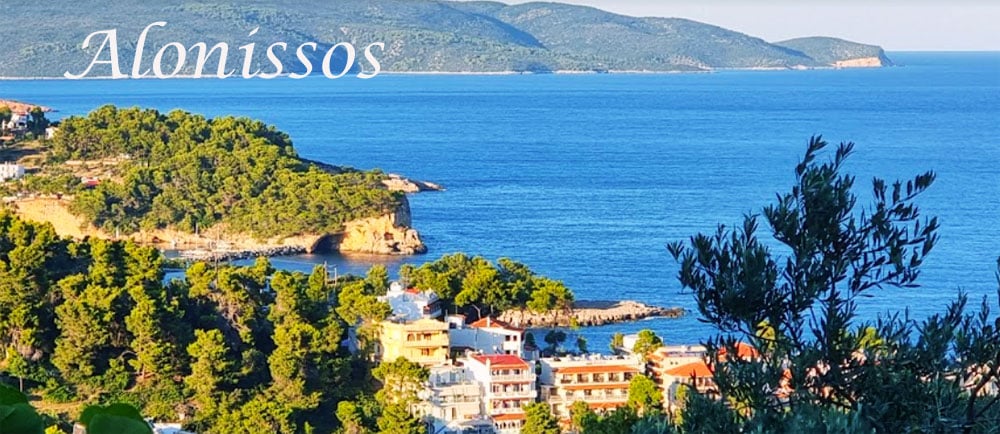Alonissos island Greece
Alonissos, situated in the Sporades archipelago, a small verdant island in the northeast of Skopelos. It is renowned for its mythical heroes, ancient shipwrecks, and submerged cities. The island occupies a privileged position, boasting fertile land. Its allure is heightened by its historically famous wine. Undoubtedly, the history enveloping Alonissos is an invaluable treasure!
Alonissos stands as one of the last ecological paradises of the Mediterranean. It is home to the Mediterranean seal and serves as a maritime haven where nature and culture coexist harmoniously, providing unparalleled excitement for adventure enthusiasts and nature lovers.
Alonissos is an ideal destination for tranquil and carefree holidays. Its turquoise waters present visitors with both organized and untouched beaches, as well as remarkable spots to explore and unwind. The southeast coast boasts a multitude of diverse beaches. Visitors can find yellow sandy shores, colourful stones, steep pale yellow rocks, and reddish cliffs in various parts of the island. Many of these beaches are tucked away in bays surrounded by pine forests and olive groves.
The northwest side of the island is rocky and largely inaccessible from land due to its sheer cliffs that drop steeply into the sea. On the northern side, small beaches can only be reached by boat, while some beaches on the southern side can be accessed by road or on foot.
Dozens of churches and countless chapels can be discovered throughout the island. The traditional architecture and historical significance of these religious structures leave a lasting impression on visitors. Moreover, the panoramic views that these chapels offer as a reward for those who visit them are enchanting.
The picturesque villages of Alonissos possess their own captivating charm. The traditional architecture seamlessly blends with the natural surroundings, and the friendly and welcoming residents further enhance the appeal.
Surrounding Alonissos, there are several islets, including Moules, Stavros, Manolas, Kokkinonisi, Mikros, and Agios Georgios. Additionally, there are the islands of Giura and Kyra Panagia (Pelagonisi), as well as Peristera, Piperi, Skandzoura, and Psathoura.
About the island
Alonnisos is at the centre of the National Marine Park which consists of the island itself, the surrounding waters and 25 uninhabited islets in the area. It’s the only ecologically protected marine reserve of its kind in Greece, established in 1992 with the main aim of saving the Mediterranean monk seals which are now one of the world’s most endangered species. About 50 seals live in the marine park along with many other rare species of flora and fauna.
You’ll arrive at the capital Patiri in the south east corner of the island – a bustling port set in an attractive cove flanked by pine-clad cliffs. Patiri means “winepress” referring to the days when Alonnisos was an important centre of wine production before a blight in the 1950s destroyed practically all of the island’s vines. The island’s original name was Evoinos meaning “good wine”. The decimation of the vineyards and an earthquake which destroyed the lovely hilltop capital (now called Alonnisos Town or Hora) left the islanders reeling. The capital was abandoned and the population regrouped in uninspiring, hastily constructed concrete houses in Patiri.
Patiri may not be the most attractive town in the Sporades but it’s a good base for exploring the rest of the island and has all the essential tourist services you’re likely to need including a 24-hour ATM, Internet access, car and motorbike hire and the usual plethora of waterfront bars and cafes.
Old Alonnisos Town, on the other hand, is one of the most delightful settlements in the archipelago with crooked, narrow alleyways (used by mules to transport goods before the earthquake) and spectacular 360-degree views of the island, neighbouring islets and the Greek mainland. Its traditional stone houses have been lovingly restored.
The east coast of the island is peppered with numerous secluded pebble coves some of which have a few tourist facilities – but don’t expect banana rides and jet skis at even the most popular beaches. You won’t have trouble finding a quiet cove of your own, tucked among the cliffs, even at the height of the season.
History
Alonissos has a long history dating back to ancient times. It was originally inhabited by the Dolopes, an ancient Greek tribe. The island was known as Ikos (or Icos) in ancient times.
In the 2nd century BC, the island came under Roman rule and later became part of the Byzantine Empire. During this period, Alonissos experienced economic growth, with agriculture, fishing, and trade playing important roles.
Like many Greek islands, Alonissos was under Venetian rule during the 13th to 15th centuries. Later, it came under Ottoman control in the 16th century.
During the 17th and 18th centuries, the Aegean Sea was plagued by pirate attacks, and Alonissos was not spared. The island suffered from piracy, and its population declined significantly. Many residents moved to safer locations on the mainland.
Alonissos, along with the other Sporades islands, was incorporated into the modern Greek state in 1830 after the Greek War of Independence. However, the island’s population continued to dwindle, and by the mid-20th century, it was largely abandoned.
In the 1960s and 1970s, efforts were made to repopulate Alonissos and revitalize the island. The establishment of the National Marine Park of Alonissos-Northern Sporades in 1992 played a significant role in the island’s revival. The park, the first marine protected area in Greece, was established to protect the endangered Mediterranean monk seal and the unique marine ecosystem.
Geography of the island
Alonissos has a rugged coastline with numerous bays, coves, and rocky cliffs. The island is known for its beautiful beaches, some of which are sandy while others are pebbly. Popular beaches include Patitiri, Chrisi Milia, Kokkinokastro, and Leftos Gialos.
Nature: Alonissos is characterized by its rich natural beauty and diverse ecosystems. The island is largely covered in pine forests, olive groves, and maquis vegetation. It is also home to the National Marine Park of Alonissos, Northern Sporades, which was established to protect the endangered Mediterranean monk seal population. The park encompasses both land and sea areas and is an important breeding ground for marine life.
Land resources: Alonissos has limited arable land due to its rocky terrain. However, agriculture is still practiced on the island, with olives, grapes, figs, and citrus fruits being the main cultivated crops. Beekeeping is also a common activity, taking advantage of the island’s natural vegetation. Fishing and aquaculture are important industries, with local fishermen catching fresh seafood such as octopus, sardines, and anchovies.
The island’s natural resources also include marble and limestone, although mining activities are not significant. Alonissos is mainly focused on preserving its natural environment and promoting sustainable tourism.
In recent years, eco-tourism has become increasingly popular on the island, attracting visitors who appreciate its unspoiled landscapes, clear waters, and diverse marine life. Visitors can enjoy activities such as hiking, diving, and exploring the island’s numerous walking trails.
Alonissos villages
While Alonissos is known for its natural beauty and marine park, it has a limited number of villages and towns.
Patitiri
Patitiri is the capital and main port of Alonissos. It is located on the southeastern coast and serves as the primary gateway for visitors arriving by ferry. Patitiri offers a range of facilities, including shops, restaurants, cafes, and accommodation options. The harbor area is vibrant and bustling, with fishing boats and yachts moored alongside each other.
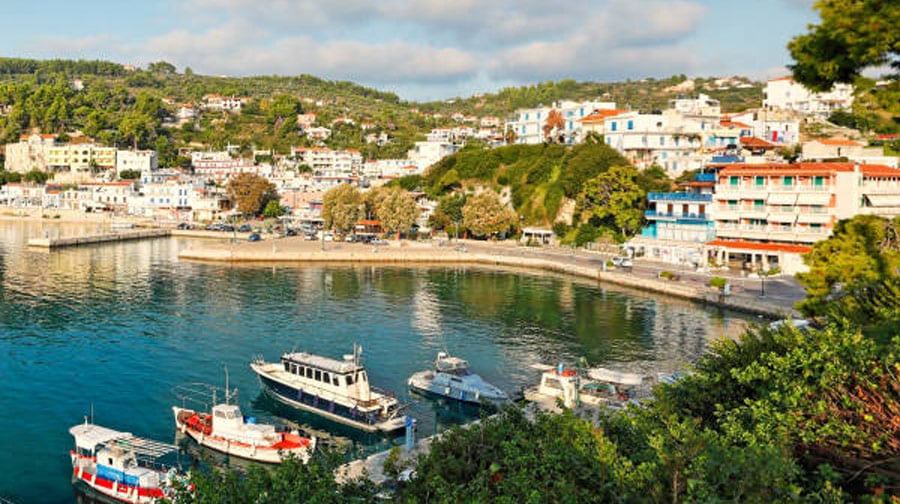
Chora
Chora, also referred to as the Old Village or Alonissos Town, is situated on a hilltop around 3 kilometers north of Patitiri. This picturesque village is characterized by its traditional stone houses, narrow alleyways, and panoramic views of the surrounding area. Chora features traditional tavernas, small shops, and a few accommodations. It is a popular spot for visitors seeking a more authentic and tranquil experience.
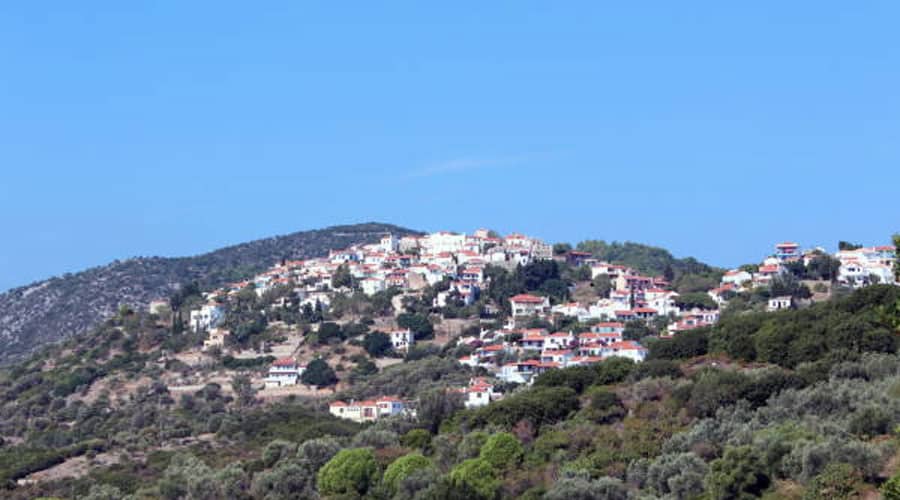
Votsi
Votsi is located approximately 2 kilometers northeast of Patitiri, Votsi is a charming coastal village known for its crystal-clear waters and beautiful natural surroundings. It is nestled in a small bay and offers a peaceful and relaxed atmosphere. Votsi has a small harbor where fishing boats and yachts can be found. Visitors can find tavernas, a mini-market, and accommodation options here.
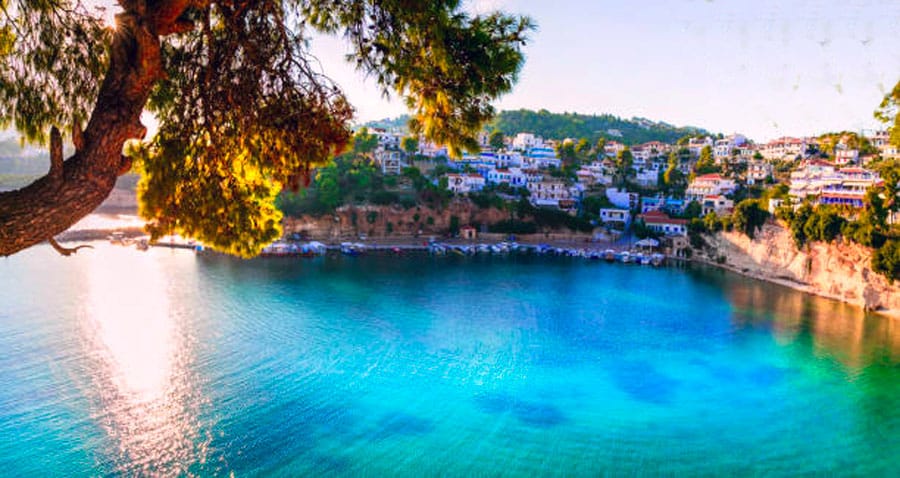
Steni Vala
Steni Vala is a picturesque fishing village located on the northeastern coast of Alonissos. Surrounded by lush green hills and olive groves, this village is a popular destination for those seeking a tranquil and authentic Greek experience. Steni Vala has a small marina where fishing boats and private yachts dock. The village offers traditional tavernas serving fresh seafood and local delicacies.
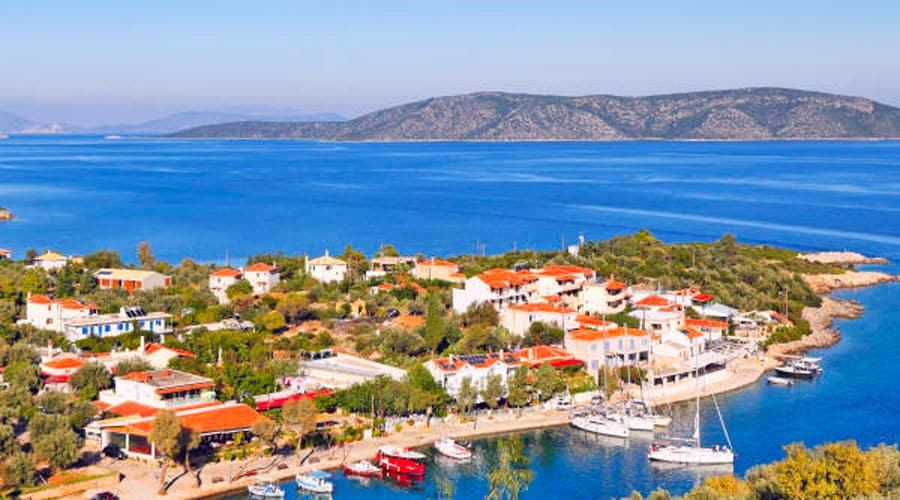
Rusum Gialos
Rousum Gialos is a small settlement in the neighboring bay from Patitiri and just 10 minutes walk from the port. There is a wide beautiful beach covered with pebbles and stones, which continue deep into the crystal clear waters. All around the beach are steep cliffs with pine trees hanging over the water, but further out, where the bay opens out to sea, the cliffs flatten out creating a wonderful view of the horizon.
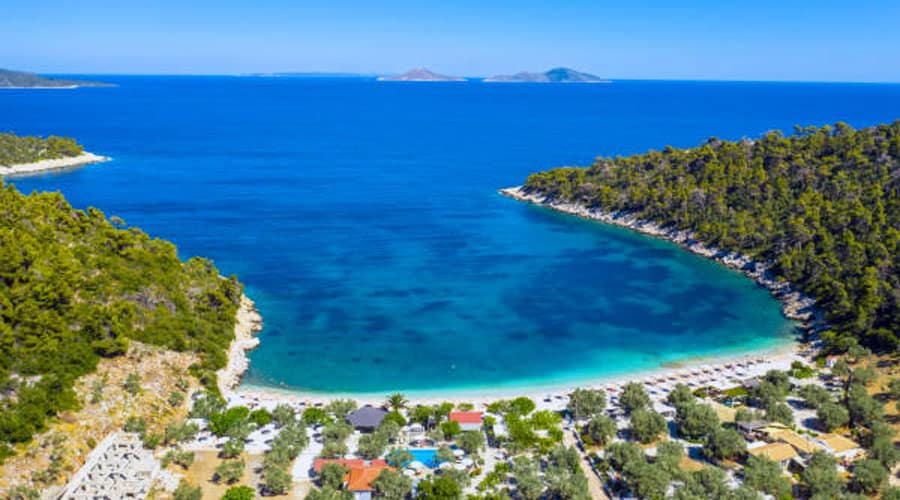
Kalamakia
Kalamakia village ituated on the northeastern coast of the island, Kalamakia is a small fishing village known for its tranquil atmosphere and natural beauty. It features a small harbor where fishing boats are moored. Kalamakia offers a few tavernas where visitors can enjoy freshly caught fish and local cuisine.
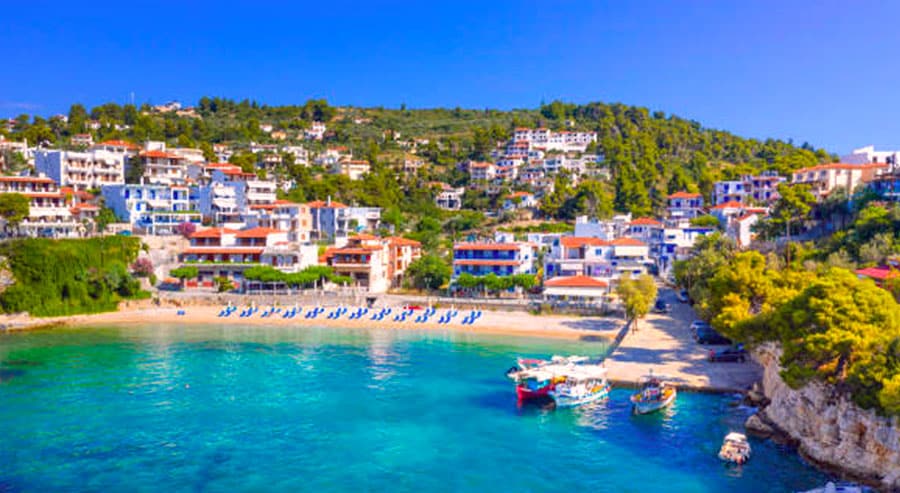
Getting around Alonissos
The best way to get around on Alonnisos is on a motorbike or scooter unless you’re a hardened hiker keen to explore the hinterland on foot. Car hire is available in the main port of Patiri but this is a one-road island with numerous dirt tracks leading down to the east coast beaches so two-wheeled transport is ideal.
Many of the tracks are steep and slippery so make sure you wear a helmet and check that your travel insurance covers you for motorbike accidents.
You’ll find plenty of motorbike rental outlets along Pelasgon and Ikion Dolopon in Patiri. Ikos Travel can arrange car hire for you or if you like the idea of exploring the island’s many good beaches by boat, Patiri Travel on Pelasgon rents out four-person motorboats. Anoter way to discover the island by foot are by hiking the wonderful walking paths of the island.
Shopping in Alonissos
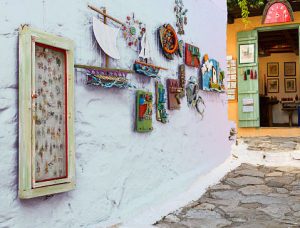
At Patitiri you’ll find a variety of shops, including supermarkets, bakeries, and souvenir stores. You can browse through the local crafts, olive oil products, honey, herbs, and other traditional Greek products. There are also clothing boutiques and jewelry stores.
The Old Village, also known as Chora, offers a unique shopping experience with several small shops selling local products, handmade crafts, and artwork. You can find items like handmade ceramics, textiles, paintings, and jewelry. Exploring the charming streets of the Old Village is a delightful experience in itself.
Alonissos hosts weekly markets where you can buy fresh produce, fruits, vegetables, and local delicacies. These markets are a great way to experience the island’s local flavors and interact with the friendly locals. Keep an eye out for the market schedules, as they may vary depending on the season.
Alonissos is famous for its high-quality olive oil production. You can find various olive oil products, such as bottles of extra virgin olive oil, olive oil soaps, and beauty products made from olive oil. Look for local producers or specialty shops that offer these authentic products.
Alonissos is home to many skilled artisans who create unique handmade crafts. Look for shops or workshops that sell pottery, woodwork, handmade textiles, and other artisanal products. These items make for great souvenirs or gifts to take back home.
Alonissos has a strong fishing tradition, and you can find the local fishermen’s cooperative in Patitiri. Here, you can buy freshly caught fish and seafood, allowing you to enjoy the island’s culinary delights in your own accommodation.
Remember to explore the local shops and support the island’s economy by purchasing locally produced items. The shopkeepers are usually friendly and happy to assist you in finding the perfect souvenir or gift. Enjoy your shopping experience in Alonissos!
What to do
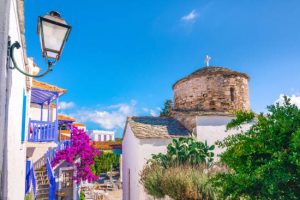
The town is topped by the ruins of a 15th century Venetian castle from where you can enjoy breathtaking 360-degree views of the island and surroundings islets of the National Marine Park. On the clearest days you can see as far as Mount Olympus, 177 kilometres away in northern Greece.
The town has some interesting little shops, a tiny museum and the beautiful chapel of Tou Christou with its fish-scale roof. You’ll be able to see inside the chapel if one of the local shopkeepers can track down the key holder for you.
You might want to plan a lunch stop in Old Alonnisos because there are some good local tavernas with wonderful views of the island and sea. At Aloni, at the base of an old windmill near the bus station, you can tuck into good quality taverna fare on an outdoor terrace with fabulous sea views.
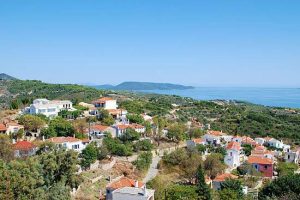
You can turn off the road down a number of tracks which lead to the beaches and secluded coves peppering the east coast. At Kokkinokastro, four kilometres north east of Patiri, there’s an archaeological site which has revealed evidence of one of the oldest prehistoric settlements in the Aegean. There’s not a great deal to see in terms of archaeological treasures but it’s a beautiful spot with red cliffs and a pebble beach flanked by pine trees and lapped by crystal clear water.
The small fishing village of Steni Vala, three kilometres further along the coast from Kokkinokastro, is the perfect place for a seafood lunch. And you can find out more about the monk seal project at the local research centre.
Best time to visit Alonissos
The best time to visit Alonissos depends on your preferences and what you want to experience during your trip. The best time to visit Alonissos would be during the spring (April to May) or autumn (September to October) when the weather is pleasant, and the island is less crowded. It’s a good balance between enjoyable weather and a more relaxed atmosphere.
Summer (June to August): This is the peak tourist season in Alonissos. The weather is hot and sunny, with temperatures ranging from the mid-20s to low 30s degrees Celsius (mid-70s to low 90s degrees Fahrenheit). The sea is warm, making it ideal for swimming and other water activities. However, keep in mind that it can get crowded during this time, especially in July and August.
Spring (April to May) and Autumn (September to October): These shoulder seasons offer a more pleasant climate with mild temperatures. Spring is characterized by blooming flowers and lush greenery, while autumn has pleasant sea temperatures for swimming. These periods are less crowded compared to summer, and you can enjoy a more relaxed atmosphere on the island.
Winter (November to March): Alonissos is relatively quiet during winter, and many businesses and tourist services may be closed. The weather is cooler, with average temperatures ranging from 10 to 15 degrees Celsius (50 to 60 degrees Fahrenheit). However, if you enjoy solitude, peacefulness, and don’t mind cooler weather, visiting during the winter months can offer a unique experience.
Local food and cuisine
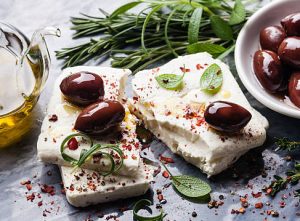
Alonissos has its own unique local food and cuisine that showcases the flavors and traditions of the region.
Given its coastal location, Alonissos is known for its fresh and delicious seafood. You can enjoy a variety of fish and shellfish dishes, such as grilled octopus, fried calamari, and stuffed squid. Some popular seafood specialties include psarosoupa (fish soup) and bourdeto (a spicy fish stew).
You can try local cheeses like feta, kefalotyri, and graviera. These cheeses are often used in traditional dishes or enjoyed on their own with some olives and bread.
Ladopita, also known as olive oil pie, is a local specialty of Alonissos. It is a savory pie made with phyllo pastry, filled with a mixture of local greens, herbs, and plenty of olive oil. It is a delicious and unique dish that showcases the island’s olive oil production.
Alonissos has a small but growing wine production. You can find local wines made from indigenous grape varieties, such as Athiri and Limnio. These wines are often crisp, refreshing, and pair well with the local cuisine.
The beaches of Alonissos
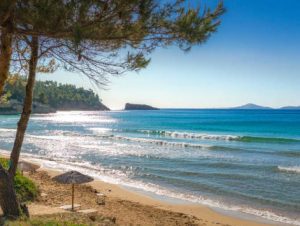
Renowned for its pristine natural beauty and crystal-clear turquoise waters, Alonissos offers an array of stunning beaches that attract visitors from around the world.
With its unspoiled landscapes, tranquil atmosphere, and diverse marine life, this island paradise is the perfect destination for beach lovers and nature enthusiasts alike.
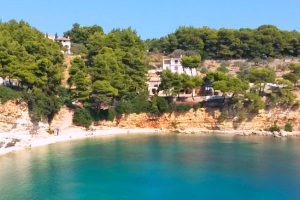
If you are a fan of organized beaches, then you must visit Agios Dimitrios, a unique and exotic beach with deep blue waters and white sand. Another beloved beach is that of Leftos Gialos. The beach is surrounded by gray rocks and covered with white stones and very fine pebbles.
It is very likely that you have heard of Kokkinokastro as it is one of the most impressive beaches of the island with its deep blue sea, steep cliffs, yellow sand, colorful stones and green pine trees.
Where to stay
Alonissos is a small island and accommodation is limited, especially in the high season so better to not to turn up without an advance booking. Room owners do meet the ferry offering rooms to let and there is help at the island room-owners association office on the waterfront.
There are several small and medium size hotels in the port, most of them located on the hill overlooking the harbour but rooms here are usually booked well in advance. There are more apartments and rooms to let in Chora and also at Rousoum, Votsi, Steni-Vala and at Kalamakia.
Almost all visitors base themselves in Patitiri or Rousoum where there are the best facilities. Steni Vala is the main choice of visitors away from the main port. There are now plenty of rooms in the resort, some shopping and several good tavernas.
New accommodation has been built near Geladias. but there is virtually northing north of there except a few rooms at the fishing hamlet of Kalamakia. For those on a tight budget there are camping sites at Plakes, near Patitiri harbour
How to get there
By Air
You can get to Alonissos by air with a flight at the nearby Skiathos Airport (JSI), officially called Alexandros Papadiamantis International), and then get one of the regular hydrofoils or ferries that run from Skiathos to ports at Skopelos and then on to Alonissos.
The port at Skiathos is only about three kilometres from the airport, recently extended, which takes charter flights throughout the summer including many direct flights from the UK each summer.
There are daily domestic flights from Athens (journey time about 20 minutes) with Olympic Air and Aegean Airlines.
By ferry
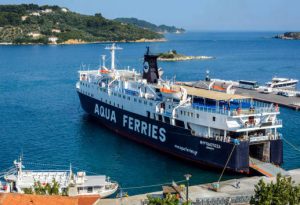
Mantoudi and Kymi are obviously more economical solutions since in the first one the ferry costs each passenger 50€ one way, while for the car he calculated 130€ round trip.
Correspondingly, the petrol going to Mantoudi will not exceed €60 and the toll €8. If you choose Kymi again, you calculate €50 per person for a return ticket, while the corresponding ticket for the car costs €118 one way. For gas and tolls, calculate at €60 round trip.
Facts about Alonissos
Size: 80 sq km
Population: 3,000
Season: May – Oct
Special interests: Walks
Useful telephones
Medical centre: +030 24240 65208
Police: +030 24240 65205
Fire fighters: +030 24240 65205
Port: +030 24240 65205
Taxis: +030 24240 65751,24240 65449,24240 65061, 24240 65425
Rooms for rent association:+030 24240 66188
Hotel association:+030 24240 65212
